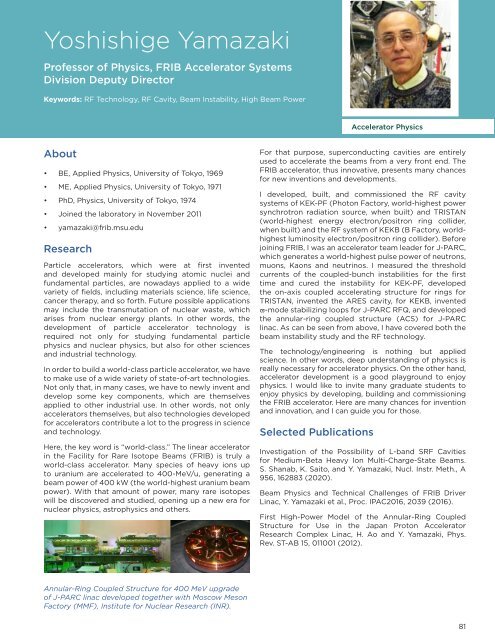202 FRIB Graduate Brochure
You also want an ePaper? Increase the reach of your titles
YUMPU automatically turns print PDFs into web optimized ePapers that Google loves.
Yoshishige Yamazaki<br />
Professor of Physics, <strong>FRIB</strong> Accelerator Systems<br />
Division Deputy Director<br />
Keywords: RF Technology, RF Cavity, Beam Instability, High Beam Power<br />
Accelerator Physics<br />
About<br />
• BE, Applied Physics, University of Tokyo, 1969<br />
• ME, Applied Physics, University of Tokyo, 1971<br />
• PhD, Physics, University of Tokyo, 1974<br />
• Joined the laboratory in November 2011<br />
• yamazaki@frib.msu.edu<br />
Research<br />
Particle accelerators, which were at first invented<br />
and developed mainly for studying atomic nuclei and<br />
fundamental particles, are nowadays applied to a wide<br />
variety of fields, including materials science, life science,<br />
cancer therapy, and so forth. Future possible applications<br />
may include the transmutation of nuclear waste, which<br />
arises from nuclear energy plants. In other words, the<br />
development of particle accelerator technology is<br />
required not only for studying fundamental particle<br />
physics and nuclear physics, but also for other sciences<br />
and industrial technology.<br />
In order to build a world-class particle accelerator, we have<br />
to make use of a wide variety of state-of-art technologies.<br />
Not only that, in many cases, we have to newly invent and<br />
develop some key components, which are themselves<br />
applied to other industrial use. In other words, not only<br />
accelerators themselves, but also technologies developed<br />
for accelerators contribute a lot to the progress in science<br />
and technology.<br />
Here, the key word is “world-class.” The linear accelerator<br />
in the Facility for Rare Isotope Beams (<strong>FRIB</strong>) is truly a<br />
world-class accelerator. Many species of heavy ions up<br />
to uranium are accelerated to 400-MeV/u, generating a<br />
beam power of 400 kW (the world-highest uranium beam<br />
power). With that amount of power, many rare isotopes<br />
will be discovered and studied, opening up a new era for<br />
nuclear physics, astrophysics and others.<br />
For that purpose, superconducting cavities are entirely<br />
used to accelerate the beams from a very front end. The<br />
<strong>FRIB</strong> accelerator, thus innovative, presents many chances<br />
for new inventions and developments.<br />
I developed, built, and commissioned the RF cavity<br />
systems of KEK-PF (Photon Factory, world-highest power<br />
synchrotron radiation source, when built) and TRISTAN<br />
(world-highest energy electron/positron ring collider,<br />
when built) and the RF system of KEKB (B Factory, worldhighest<br />
luminosity electron/positron ring collider). Before<br />
joining <strong>FRIB</strong>, I was an accelerator team leader for J-PARC,<br />
which generates a world-highest pulse power of neutrons,<br />
muons, Kaons and neutrinos. I measured the threshold<br />
currents of the coupled-bunch instabilities for the first<br />
time and cured the instability for KEK-PF, developed<br />
the on-axis coupled accelerating structure for rings for<br />
TRISTAN, invented the ARES cavity, for KEKB, invented<br />
π-mode stabilizing loops for J-PARC RFQ, and developed<br />
the annular-ring coupled structure (ACS) for J-PARC<br />
linac. As can be seen from above, I have covered both the<br />
beam instability study and the RF technology.<br />
The technology/engineering is nothing but applied<br />
science. In other words, deep understanding of physics is<br />
really necessary for accelerator physics. On the other hand,<br />
accelerator development is a good playground to enjoy<br />
physics. I would like to invite many graduate students to<br />
enjoy physics by developing, building and commissioning<br />
the <strong>FRIB</strong> accelerator. Here are many chances for invention<br />
and innovation, and I can guide you for those.<br />
Selected Publications<br />
Investigation of the Possibility of L-band SRF Cavities<br />
for Medium-Beta Heavy Ion Multi-Charge-State Beams.<br />
S. Shanab, K. Saito, and Y. Yamazaki, Nucl. Instr. Meth., A<br />
956, 162883 (<strong>202</strong>0).<br />
Beam Physics and Technical Challenges of <strong>FRIB</strong> Driver<br />
Linac, Y. Yamazaki et al., Proc. IPAC2016, 2039 (2016).<br />
First High-Power Model of the Annular-Ring Coupled<br />
Structure for Use in the Japan Proton Accelerator<br />
Research Complex Linac, H. Ao and Y. Yamazaki, Phys.<br />
Rev. ST-AB 15, 011001 (2012).<br />
Annular-Ring Coupled Structure for 400 MeV upgrade<br />
of J-PARC linac developed together with Moscow Meson<br />
Factory (MMF), Institute for Nuclear Research (INR).<br />
81<br />
<strong>202</strong>2_<strong>FRIB</strong>_<strong>Graduate</strong>_<strong>Brochure</strong>v4.indd 81<br />
10/29/<strong>202</strong>1 3:33:58 PM






